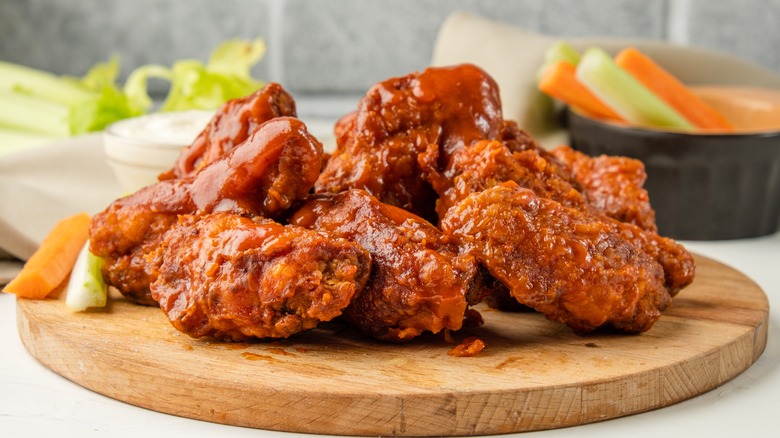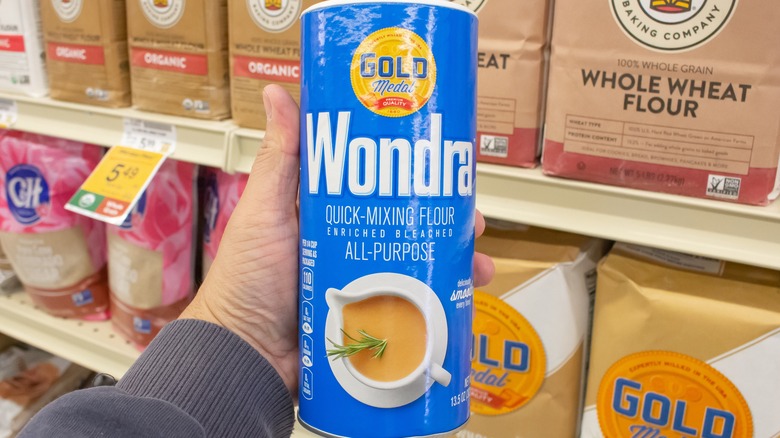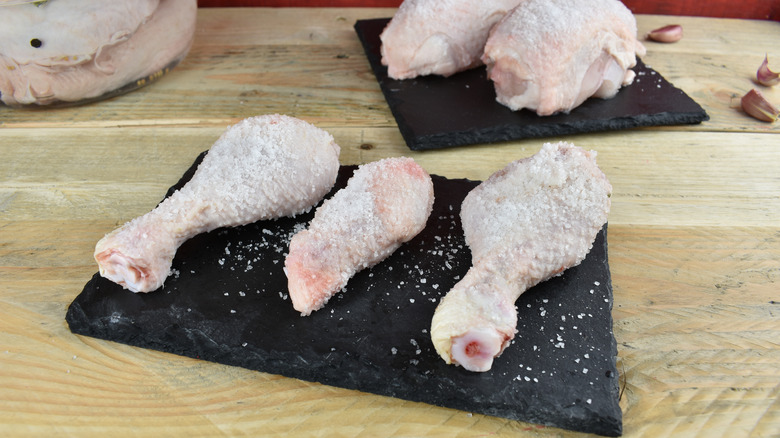This Ingredient Combo Holds The Secret To Ultra Crispy Fried Chicken Wings
There's nothing like a plate of hot and crispy chicken wings to enjoy on game day or any other day of the week. Whether you enjoy them in the classic, spicy Buffalo style or prefer them smothered in barbecue sauce, the key to the tastiest drums and flats is perfecting the crunchy coating. To achieve the ultimate crispy chicken wings, you'll want to coat them in a winning combination of Wondra and potato starch.
Wondra is a brand of instant or quick-rising flour made from wheat and malted barley. It has less protein and a finer texture than regular wheat flour. It has also been pregelatinized, meaning it's been steamed before being dried. This process keeps it from clumping when added to liquid, making it ideal as a thickening agent for gravies and sauces. It also works great for frying fish and vegetables, and as a substitute for rice flour in tempura batter.
The other secret ingredient for the crispiest wings imaginable is potato starch, which is made from the opaque white liquid you see when potatoes are soaked in water. The liquid starch is extracted from the tubers and dried, resulting in a fine powder (not to be confused with potato flour which is made from whole potatoes and not just the extracted starch). Potato starch can also be used as a thickener (mixed with water first to prevent clumping) and makes a perfect coating for frying foods.
Why these starchy ingredients make wings extra crispy
Starch is a key component in deep-frying, giving your food a deliciously crispy outside. As far as its molecular structure goes, starch is composed of the glucose molecules amylose and amylopectin. When heated in oil, these starch granules expand, giving the amylose molecules room to spread out and form a stiff, open grid that results in the crispy coating you see on your perfect fried chicken. The more amylose, the crispier your coating will be. The high content of amylose in potato starch, as well as other factors such as the large granule size compared to other starches like cornstarch, contribute to the ultimate crunchy coating on your fried food.
Wondra, the other half of the best ingredient combo for coating your wings, is the perfect flour to use because it has a low protein content. The higher protein content a particular flour has, the more gluten it can form. Gluten absorbs moisture at a high rate, so too much protein/gluten in your dredge or batter can result in an unpleasantly chewy, stodgy crust, which is undoubtedly what you want to avoid when making chicken wings. Yet, having some gluten is useful for helping the flour stick to the chicken, which is why adding Wondra to potato starch will give you an ideal mixture for frying.
Tips for frying the crispiest chicken wings
Using instant flour and potato starch is an easy way to upgrade your fried chicken. You simply dust the poultry parts with a 50/50 mixture of Wondra and potato starch, deep fry until golden brown, then toss them in (or serve alongside) your preferred sauce.
Some cooks swear by brining wings — covering them with salt and other seasonings — before frying them. This results in super moist, flavorful chicken on the inside and deliciously crispy skin on the outside. When it comes to brining your chicken wings, you have two choices: wet or dry.
You can wet brine your wings by soaking them in a mixture of salt and water for a couple of hours in the refrigerator. This will add moisture and loosen the tough muscle fibers in the chicken, protecting the meat against drying out. Optionally, you can add sugar to the brine to help create a more caramelized, crispy crust on your wings, as well as spices for flavor.
While opinions differ on whether its best to use a wet brine versus a dry brine on chicken wings, some say a dry brine — adding the salt directly to the chicken and skipping the water — will produce a crispier skin on your wings. Another useful tip for extra crispiness is to add baking powder to dry brines. After brining your wings, coat them in the Wondra/potato starch mixture before frying. You may never fry them any other way.


